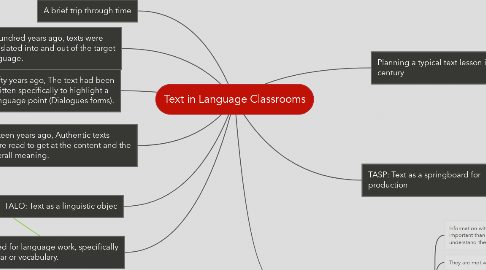Text in Language Classrooms
by Julio Aguirre

1. A hundred years ago, texts were translated into and out of the target language.
2. A brief trip through time
3. TALO: Text as a linguistic objec
4. Fifty years ago, The text had been written specifically to highlight a language point (Dialogues forms).
5. Fifteen years ago, Authentic texts were read to get at the content and the overall meaning.
6. It is used for language work, specifically grammar or vocabulary.
6.1. pedagogical purpose
6.2. Authentic text "adapted"
6.3. Find words to classify their language language function.
7. TAVI: Text as a vehicle for information
7.1. Information within the text is seen as more important than the language. Students should understand the overall meaning of a text.
7.2. They are motivating.
7.3. They encourage the students to read.
7.4. They are authentic texts.
7.5. Activities: Predicting, discussing, answering questions, summarising, put events together.
8. TASP: Text as a springboard for production
8.1. For example, usually a reading or writing task.
8.2. Activities: Role plays, debates, discussing, writing something that is known, and writing a response to the text.
9. Planning a typical text lesson in the 21st century
9.1. Choose a text that you think will be interesting and motivating.
9.2. Look for particular grammar or vocabulary that is worthy of mention in the text and design activities that can bring that out.
9.3. Think of what kind of task the students could do once they've finished with the text.
9.4. In class, start with TAVI-type activities, so that the students understand the information in the text.
9.5. Look at the language in the text in closer detail, through TALO-type activities.
9.6. Close the lesson off with a TASP activity.


